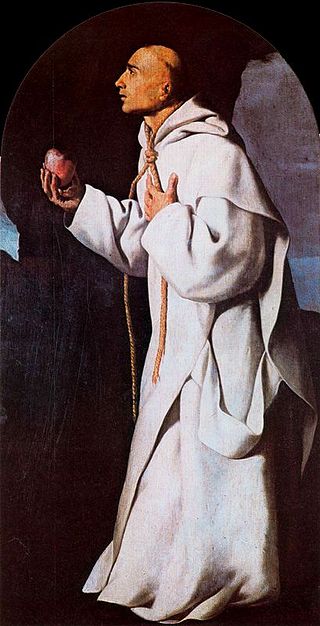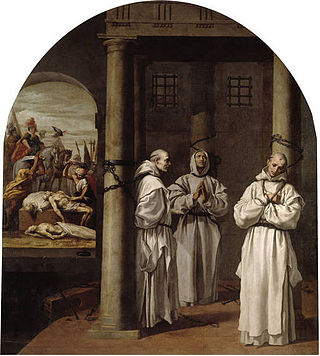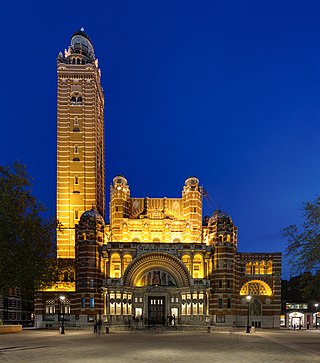
Richard Reynolds, OSsS was an English Bridgettine monk executed in London for refusing the Oath of Supremacy to King Henry VIII of England. He was canonised by Pope Paul VI in 1970, among the Forty Martyrs of England and Wales.

The Forty Martyrs of England and Wales or Cuthbert Mayne and Thirty-Nine Companion Martyrs are a group of Catholic, lay and religious, men and women, executed between 1535 and 1679 for treason and related offences under various laws enacted by Parliament during the English Reformation. The individuals listed range from Carthusian monks who in 1535 declined to accept Henry VIII's Act of Supremacy, to seminary priests who were caught up in the alleged Popish Plot against Charles II in 1679. Many were sentenced to death at show trials, or with no trial at all.

John Houghton, OCart was a Catholic priest of the Carthusian order and the first martyr to die as a result of the Act of Supremacy by King Henry VIII of England. He was also the first of the Carthusians to die as a martyr. As one of the Carthusian Martyrs of London he is among the Forty Martyrs of England and Wales.
Dom Maurice Chauncy was an English Catholic priest and Carthusian monk.

John Rochester, O.Cart was an English Catholic priest, Carthusian monk and martyr. He was hanged at York for refusing to concede King Henry VIII's supremacy over the church.

William Exmew, O.Cart was an English Catholic priest and Carthusian hermit. He was hanged, drawn, and quartered at Tyburn and is honoured as a martyr by the Catholic Church. Exmew and his brother Carthusian martyrs were beatified by Pope Leo XIII on 9 December 1886.

Humphrey Middlemore, OCart was an English Catholic priest and Carthusian hermit, who was executed for treason during the Tudor period. He is considered a martyr by the Catholic Church, and, along with other members of his religious order to meet that fate, was beatified by Pope Leo XIII on 9 December 1886.

Sebastian Newdigate, O.Cart was the seventh child of John Newdigate, Sergeant-at-law. He spent his early life at court, and later became a Carthusian monk. He was executed for treason on 19 June 1535 for his refusal to accept Henry VIII's assumption of supremacy over the Church in England. His death was considered a martyrdom, and he was beatified by the Catholic Church.

The Carthusian Martyrs of London were the monks of the London Charterhouse, the monastery of the Carthusian Order in the City of London who were put to death by the English state in a period lasting from the 4 May 1535 until the 20 September 1537. The method of execution was hanging, disembowelling while still alive and then quartering. Others were imprisoned and left to starve to death. The group also includes two monks who were brought to that house from the Charterhouses of Beauvale and Axholme and similarly dealt with. The total was 18 men, all of whom have been formally recognized by the Catholic Church as martyrs.

The Catholic Church in the United Kingdom is part of the worldwide Catholic Church in communion with the Pope. While there is no ecclesiastical jurisdiction corresponding to the political union, this article refers to the Catholic Church's geographical representation in mainland Britain as well as Northern Ireland, ever since the establishment of the UK's predecessor Kingdom of Great Britain by the Union of the Crowns in 1707.
Robert Lawrence, OCart was one of the Forty Martyrs of England and Wales. He was hanged, drawn, and quartered at Tyburn for declining to sign the Oath of Supremacy. His feast day is 4 May.

Beauvale Priory was a Carthusian monastery in Beauvale, Nottinghamshire. It is a scheduled ancient monument.
Events from the 1530s in England.

Owston Ferry is a village and civil parish in North Lincolnshire, England. It is situated on the west bank of the River Trent, and 9 miles (14 km) north from Gainsborough. It had a total resident population of 1,128 in 2001 including Kelfield. This increased to 1,328 at the 2011 census. Sometimes referred to as Owston or Ferry, the village forms part of the Isle of Axholme. It is bounded to the west by the A161 road and the village of Haxey. The River Trent is directly to the east. To the north, beyond a number of hamlets and villages, lies the Humber estuary. West Butterwick was originally a part of the township of Owston.
Axholme Charterhouse or Axholme Priory, also Melwood Priory or Low Melwood Priory, North Lincolnshire, is one of the ten medieval Carthusian houses (charterhouses) in England. It was established in 1397/1398 by Thomas Mowbray, Earl of Nottingham and later Duke of Norfolk. The house was centred on a pre-existing chapel on the present Low Melwood Farm, between Owston Ferry and Epworth in the Isle of Axholme, which according to a papal bull of 1398 "was called anciently the Priory of the Wood".

John Forest was an English Franciscan friar and martyr. Confessor to Queen Catherine of Aragon, Forest was burned to death at Smithfield for heresy, in that he refused to acknowledge the King as head of the church.

Monks Kirby Priory was a Benedictine priory established in 1077 in Monks Kirby, Warwickshire, England. The priory was suppressed in 1415 when its estates and revenues were given to the Carthusian priory of Axholme in Lincolnshire, in whose possession they continued until the Reformation. Remains of the priory form part of Monks Kirby village church today.

The Carthusian martyrs are those members of the Carthusian monastic order who have been persecuted and killed because of their Christian faith and their adherence to the Catholic religion. As an enclosed order the Carthusians do not, on principle, put forward causes for their members, though causes have been promoted by others on their behalf.












